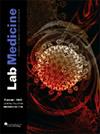创造分子氛围:第三阶段
IF 1
4区 医学
Q4 MEDICAL LABORATORY TECHNOLOGY
引用次数: 0
摘要
在我开始在OSF圣弗朗西斯医学中心系统实验室的微生物部门创造这种分子氛围之前,我对实验室开发测试(LDT)的使用并不熟悉。我在诊断测试方面的经验通常包括使用一个包含产品说明书的试剂盒,其中附有如何执行所讨论的测试的分步说明。然而,通过实时PCR进行的单纯疱疹病毒(HSV)检测和百日咳/副百日咳博德泰拉(以下简称博德泰拉)检测需要开发、验证和验证;协议需要根据我们发现成功的步骤来编写。ldt,也被称为自制测试,是内部开发的,用于研究或诊断目的。在经认证的临床实验室中不经常遇到ldt;它们更常见于研究型机构。这种类型的分析尚未得到美国食品和药物管理局(FDA)的批准,因此没有商业试剂盒可用。创建自制测定法的实验室可以自己制作试剂,也可以从外部供应商那里购买试剂,并制定自己的检测方案。信函应寄给谁?电子邮件:stephanie.e.wallace{at}osfhealthcare.org [1]: #xref-corresp-1-1本文章由计算机程序翻译,如有差异,请以英文原文为准。
Creating a Molecular Atmosphere: Phase 3
The use of laboratory-developed tests (LDT) was unfamiliar to me before I started to create this molecular atmosphere within our microbiology department at the System Laboratory of OSF Saint Francis Medical Center. My experience with diagnostic testing had usually included using a kit containing a product insert with step-by-step instructions on how to perform the test in question. However, the herpes simplex virus (HSV) assay and Bordetella pertussis/parapertussis (hereafter, Bordetella) test performed via real-time PCR needed to be developed, validated, and verified; protocols needed to be written based on the steps that we found to be successful.
LDTs, also known as home-brew tests, are developed in-house and used for research or diagnostic purposes. LDTs are not frequently encountered in certified clinical laboratories; they are more commonly found in research-based facilities. This type of assay has not been approved by the United States Food and Drug Administration (FDA), so no commercial kits are available. Laboratories that create home-brew assays can make the reagents themselves or buy reagents from outside vendors and develop their own protocol for testing. The validation …
[↵][1]* To whom correspondence should be addressed. E-mail: stephanie.e.wallace{at}osfhealthcare.org
[1]: #xref-corresp-1-1
求助全文
通过发布文献求助,成功后即可免费获取论文全文。
去求助
来源期刊

Labmedicine
医学-医学实验技术
CiteScore
2.50
自引率
0.00%
发文量
155
审稿时长
>12 weeks
期刊介绍:
Lab Medicine is a peer-reviewed biomedical journal published quarterly by the ASCP and Oxford University Press. The journal invites submission of manuscripts on topics related to clinical chemistry and microbiology, hematology, immunology, transfusion medicine, molecular diagnostics, cytology, histology, and laboratory administration and management. Original research, reviews, and case reports are considered for publication. Lab Medicine is indexed (under the title Laboratory Medicine) by the National Library of Medicine and is included in the PubMed database.
 求助内容:
求助内容: 应助结果提醒方式:
应助结果提醒方式:


